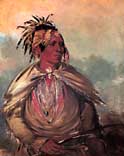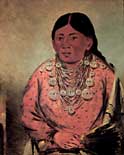
 1 |
 3 |
1. Pah-me-cow-ee-tah, or Man Who Tracks, a Peoria Illinois Chief
enlarge
2. Ah-tee-wat-o-mee, a Kickapoo woman
enlarge
3. Kee-o-kuk, or the Running Fox, a Sauk chief
enlarge

2
The . . . people of the prairies . . . are the Puants [Winnebago], the Outagamis [Fox], the Kicapoux [Kickapoo], the Mascoutins [Mascouten], the Miamis, and the Illinois. (Antoine Denis Raudot, 1709)![]()
In the 1600s, when American Indians first came into contact with Europeans in the Great Lakes region, two Native American ethnic groups inhabited the land that would eventually become the State of Illinois. The first group--known to French explorers and missionaries as the Illinois or Illiniwek Indians--was a collection of twelve tribes that occupied a large section of the central Mississippi River valley, including most of what is today Illinois. The second group, the Miami tribe, lived in villages located south and west of Lake Michigan.
During the 1700s and early 1800s, the territory of the Illinois Indians shrank and the Miami tribe moved eastward. Other tribes then moved into Illinois to take over land formerly occupied by the Illinois and Miami. Some of the newly arrived tribes included the Fox (Mesquakie), Ioway, Kickapoo, Mascouten, Piankashaw, Potawatomi, Sauk, Shawnee, Wea, and Winnebago.
This web module focuses only on the Illinois or Illiniwek Indians. In the future we plan to expand the module to include information on the Fox, Kickapoo, Miami, and other tribes that lived in Illinois historically.![]()
|
|
Copyright © 2000 Illinois State Museum